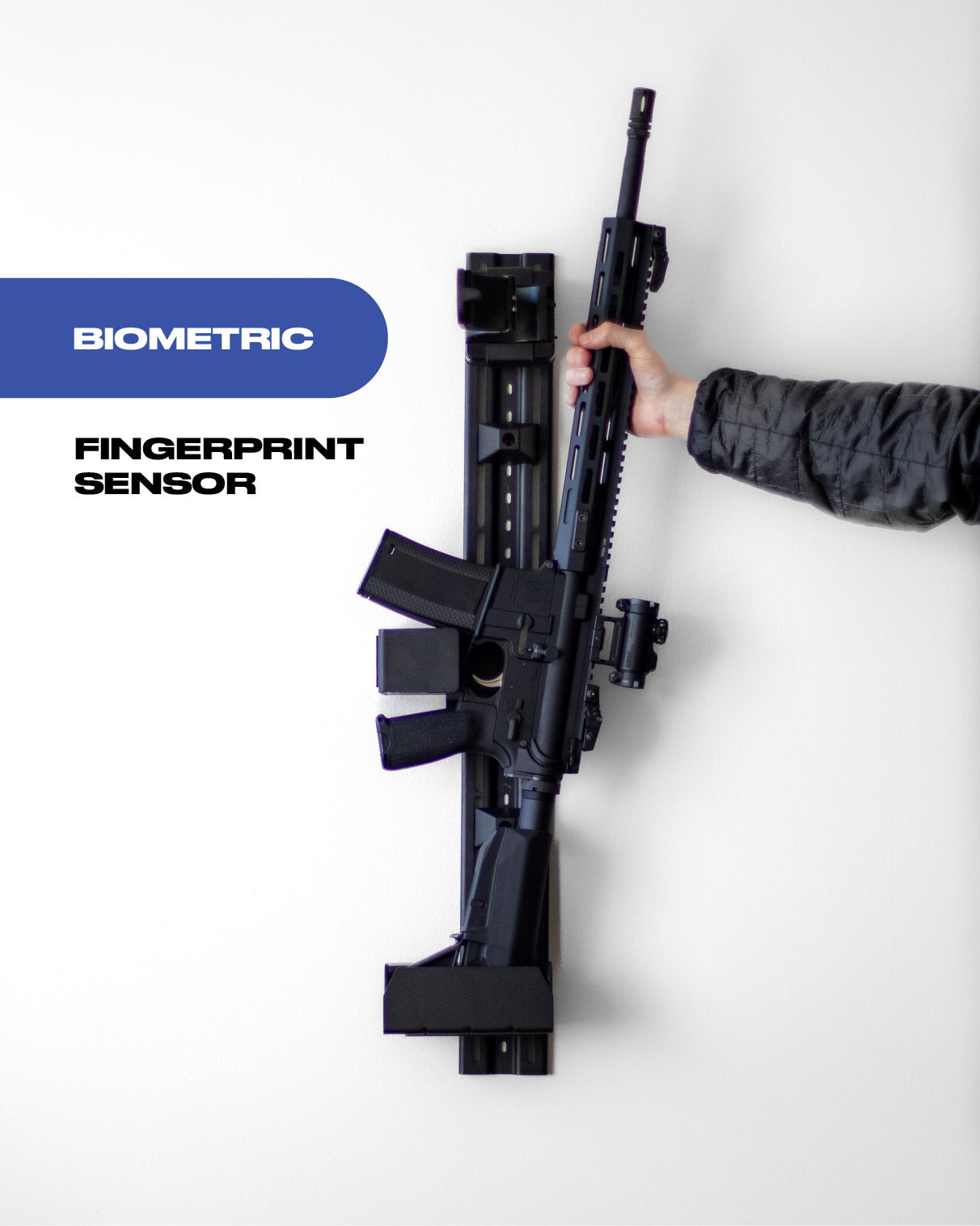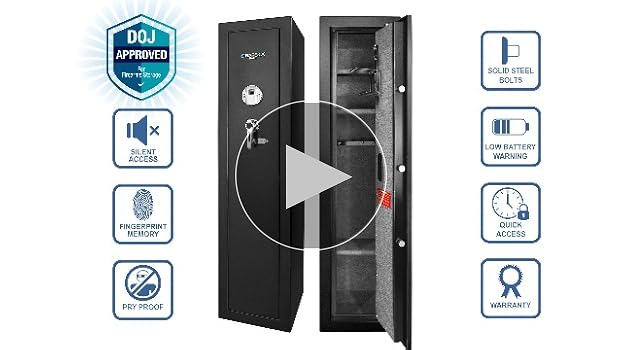Are you wondering if your biometric rifle safe needs batteries to work? It’s a question that can make a big difference in how you protect your firearms.
Imagine needing quick access to your rifle in an emergency, but your safe won’t open because the batteries died. That’s a scary thought, right? You’ll discover exactly how biometric rifle safes operate, whether they rely on batteries, and what you can do to avoid getting locked out when it matters most.
Keep reading to ensure your rifle safe is always ready when you need it.

How Biometric Rifle Safes Work
Biometric rifle safes offer a smart way to secure firearms. They use fingerprint technology to allow access. Understanding how these safes work helps you trust their security and convenience.
Basic Mechanism
Biometric rifle safes have a scanner that reads fingerprints. When you place your finger on the sensor, it captures the print’s unique patterns. The safe’s system compares this data with stored prints. If there is a match, the locking mechanism releases. This process happens in seconds, giving quick access.
The safe uses electronic components to control the lock. These parts need power to function, which usually comes from batteries. Without power, the biometric system cannot scan or unlock the safe.
Role Of Biometrics
Biometric technology relies on unique features of your fingerprint. No two fingerprints are exactly the same. This makes biometrics a reliable way to identify authorized users. The sensor reads ridges, valleys, and patterns on your finger. It then converts this information into digital data.
The safe’s software checks if the scanned fingerprint matches the saved profiles. Only authorized fingerprints open the safe. This method prevents unauthorized access and enhances security.
Power Requirements For Biometric Safes
Biometric rifle safes rely on power to operate their fingerprint scanners and electronic locks. Without power, these safes cannot recognize fingerprints or open electronically. Most biometric safes use batteries as their power source. Understanding the power needs helps users maintain their safes properly and avoid lockouts.
Knowing the type of battery and its life span is key to keeping the safe functional. Some safes also offer backup power options. Power requirements vary by model but generally depend on electronic components inside the safe.
Battery Types Used
Most biometric rifle safes use standard AA or AAA batteries. These batteries are easy to find and replace. Some high-end models use rechargeable lithium-ion batteries. Rechargeable batteries reduce waste and save money over time. Users should check the safe’s manual for the recommended battery type. Using the wrong battery can cause malfunctions or damage.
Battery Life Expectations
Battery life depends on how often the safe is opened and closed. On average, batteries last from six months to one year. Frequent use shortens battery life. Some safes have low battery indicators to warn users. Replacing batteries before they die prevents emergency lockouts. Keeping spare batteries nearby is a good practice for safety.
Battery Backup And Alternatives
Biometric rifle safes often need batteries to work. Batteries power the fingerprint scanner and electronic lock. But what happens if the battery dies? Battery backup and alternatives help keep your safe secure and accessible. These features ensure you do not get locked out at a critical time.
External Power Options
Many biometric safes offer external power options. You can connect a power bank or external battery pack. This method provides temporary power during battery failure. It keeps the scanner and lock active without replacing internal batteries. External power is handy when you cannot open the safe to change batteries.
Manual Override Features
Manual override features provide a backup unlocking method. Usually, a physical key or combination lock works as a backup. This option lets you open the safe without power. It acts as a fail-safe in emergencies or battery failure. Always keep the manual key in a secure but accessible place.

Signs Of Battery Failure
Battery failure in biometric rifle safes can cause access problems. Knowing the signs helps you act quickly. This avoids being locked out or damaging the locking system. Recognizing early symptoms keeps your safe working smoothly. Check your safe regularly for any unusual behavior.
Common Indicators
The keypad may become unresponsive or slow. The biometric scanner might fail to read fingerprints. You could hear weak or no beeping sounds. The LED lights may flicker or turn off. The safe might not open even with correct input. A low battery warning often appears on the display.
Preventive Measures
Replace batteries before they run out completely. Use high-quality batteries recommended by the manufacturer. Keep spare batteries nearby for quick replacement. Test the biometric scanner regularly to ensure proper function. Clean the fingerprint sensor to avoid reading errors. Store the safe in a cool, dry place to extend battery life.
Maintaining Battery Performance
Maintaining the battery performance in biometric rifle safes is important for reliable access. Batteries power the lock’s fingerprint scanner and keypad. Good battery care avoids unexpected lockouts and ensures quick access to your rifle.
Regular checks and proper handling keep batteries working longer. This saves money and prevents frustration. Understanding how to replace and store batteries helps keep your safe ready at all times.
Replacement Tips
Change batteries as soon as the low battery warning appears. Use high-quality alkaline or lithium batteries for best results. Avoid mixing old and new batteries or different brands. Remove batteries if you do not plan to use the safe for months. Keep spare batteries nearby for quick replacement. Follow the safe’s manual for correct battery installation to avoid damage.
Storage Considerations
Store batteries in a cool, dry place away from metal objects. Avoid extreme heat or cold, which can reduce battery life. Keep batteries in original packaging until use. Remove batteries from the safe if it will not be used for a long time. Proper storage prevents leaks and corrosion, protecting both batteries and your safe.

Benefits Of Battery-powered Safes
Battery-powered biometric rifle safes offer several key benefits. They provide reliable security and ease of use. These safes use batteries to power fingerprint scanners and electronic locks. This allows quick access while keeping your firearms safe.
Battery operation also means no need for external power sources. You can place the safe anywhere without worrying about cords or outlets. This flexibility suits various home and office setups.
Security Advantages
Battery-powered safes use advanced fingerprint technology. This stops unauthorized access effectively. The electronic lock reacts fast to your fingerprint.
Some models alert you when batteries run low. This prevents lockouts and ensures continuous protection. Batteries also allow the safe to store multiple user profiles. This means only trusted users can open the safe.
Convenience Factors
These safes open quickly with just a touch. No need to remember long codes or carry keys. Battery power supports backup options like keypad entry.
Changing batteries is simple and quick. Most safes use standard batteries available worldwide. This makes maintenance easy and hassle-free.
Frequently Asked Questions
Do Biometric Rifle Safes Require Batteries To Operate?
Yes, most biometric rifle safes need batteries to power the fingerprint scanner and locking mechanism. Battery life varies by model but typically lasts several months.
What Happens If The Biometric Safe Battery Dies?
If the battery dies, you can usually use a backup key or external power source to open the safe. Always keep spare batteries handy.
How Often Should I Replace Batteries In Biometric Safes?
It’s recommended to replace batteries every 6 to 12 months to ensure reliable access and avoid lockouts due to dead batteries.
Can Biometric Rifle Safes Work Without Batteries?
No, biometric safes rely on battery power for their electronic locking system and fingerprint recognition. Manual override options exist but still require battery maintenance.
Conclusion
Biometric rifle safes often need batteries to work properly. Batteries power the fingerprint scanner and electronic lock. Without batteries, the safe might not open quickly. Many safes use common batteries that are easy to replace. Always check battery life to avoid lockouts.
Some models have backup keys for emergencies. Choosing a safe with clear battery instructions helps. Battery maintenance keeps your firearms secure and accessible. Think about battery needs when buying a biometric safe. Staying prepared ensures safety and peace of mind.
